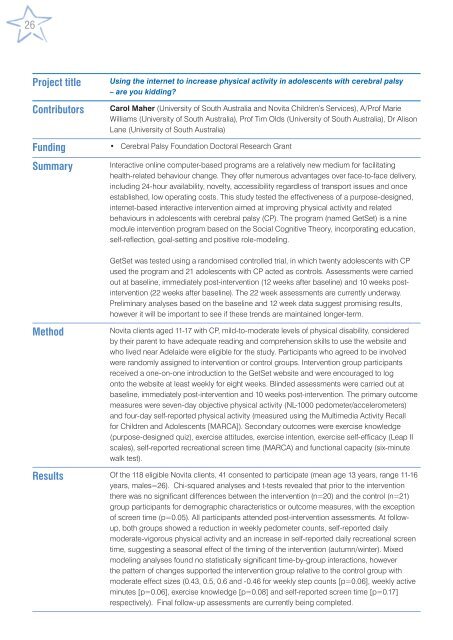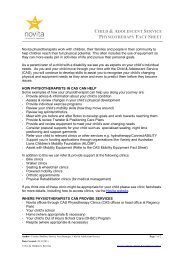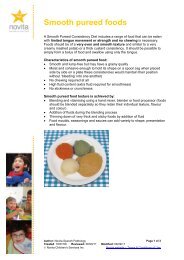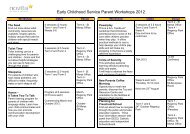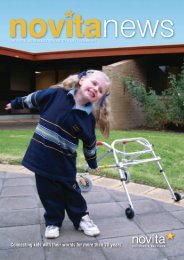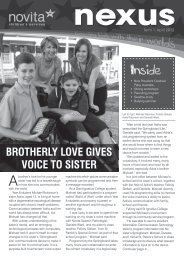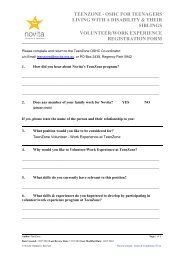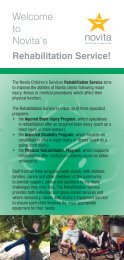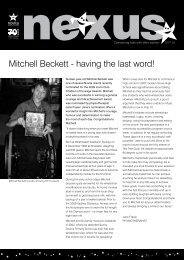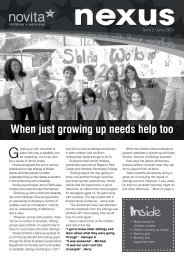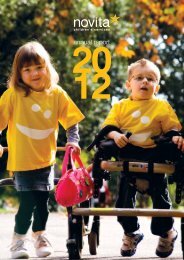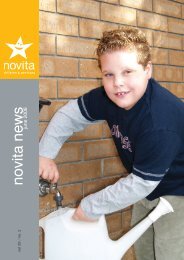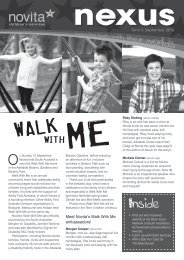Novita Research Report - 2004 to 2007 - Novita Children's Services
Novita Research Report - 2004 to 2007 - Novita Children's Services
Novita Research Report - 2004 to 2007 - Novita Children's Services
- No tags were found...
Create successful ePaper yourself
Turn your PDF publications into a flip-book with our unique Google optimized e-Paper software.
26Project titleContribu<strong>to</strong>rsFundingSummaryUsing the internet <strong>to</strong> increase physical activity in adolescents with cerebral palsy– are you kidding?Carol Maher (University of South Australia and <strong>Novita</strong> Children’s <strong>Services</strong>), A/Prof MarieWilliams (University of South Australia), Prof Tim Olds (University of South Australia), Dr AlisonLane (University of South Australia)• Cerebral Palsy Foundation Doc<strong>to</strong>ral <strong>Research</strong> GrantInteractive online computer-based programs are a relatively new medium for facilitatinghealth-related behaviour change. They offer numerous advantages over face-<strong>to</strong>-face delivery,including 24-hour availability, novelty, accessibility regardless of transport issues and onceestablished, low operating costs. This study tested the effectiveness of a purpose-designed,internet-based interactive intervention aimed at improving physical activity and relatedbehaviours in adolescents with cerebral palsy (CP). The program (named GetSet) is a ninemodule intervention program based on the Social Cognitive Theory, incorporating education,self-reflection, goal-setting and positive role-modeling.GetSet was tested using a randomised controlled trial, in which twenty adolescents with CPused the program and 21 adolescents with CP acted as controls. Assessments were carriedout at baseline, immediately post-intervention (12 weeks after baseline) and 10 weeks postintervention(22 weeks after baseline). The 22 week assessments are currently underway.Preliminary analyses based on the baseline and 12 week data suggest promising results,however it will be important <strong>to</strong> see if these trends are maintained longer-term.Method<strong>Novita</strong> clients aged 11-17 with CP, mild-<strong>to</strong>-moderate levels of physical disability, consideredby their parent <strong>to</strong> have adequate reading and comprehension skills <strong>to</strong> use the website andwho lived near Adelaide were eligible for the study. Participants who agreed <strong>to</strong> be involvedwere randomly assigned <strong>to</strong> intervention or control groups. Intervention group participantsreceived a one-on-one introduction <strong>to</strong> the GetSet website and were encouraged <strong>to</strong> logon<strong>to</strong> the website at least weekly for eight weeks. Blinded assessments were carried out atbaseline, immediately post-intervention and 10 weeks post-intervention. The primary outcomemeasures were seven-day objective physical activity (NL-1000 pedometer/accelerometers)and four-day self-reported physical activity (measured using the Multimedia Activity Recallfor Children and Adolescents [MARCA]). Secondary outcomes were exercise knowledge(purpose-designed quiz), exercise attitudes, exercise intention, exercise self-efficacy (Leap IIscales), self-reported recreational screen time (MARCA) and functional capacity (six-minutewalk test).Results Of the 118 eligible <strong>Novita</strong> clients, 41 consented <strong>to</strong> participate (mean age 13 years, range 11-16years, males=26). Chi-squared analyses and t-tests revealed that prior <strong>to</strong> the interventionthere was no significant differences between the intervention (n=20) and the control (n=21)group participants for demographic characteristics or outcome measures, with the exceptionof screen time (p=0.05). All participants attended post-intervention assessments. At followup,both groups showed a reduction in weekly pedometer counts, self-reported dailymoderate-vigorous physical activity and an increase in self-reported daily recreational screentime, suggesting a seasonal effect of the timing of the intervention (autumn/winter). Mixedmodeling analyses found no statistically significant time-by-group interactions, howeverthe pattern of changes supported the intervention group relative <strong>to</strong> the control group withmoderate effect sizes (0.43, 0.5, 0.6 and -0.46 for weekly step counts [p=0.06], weekly activeminutes [p=0.06], exercise knowledge [p=0.08] and self-reported screen time [p=0.17]respectively). Final follow-up assessments are currently being completed.


